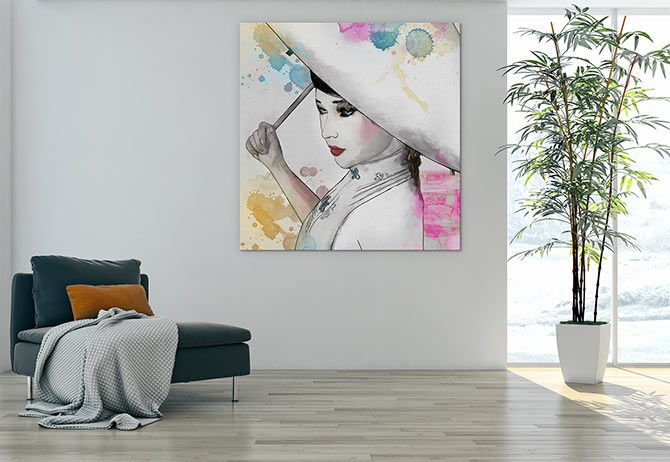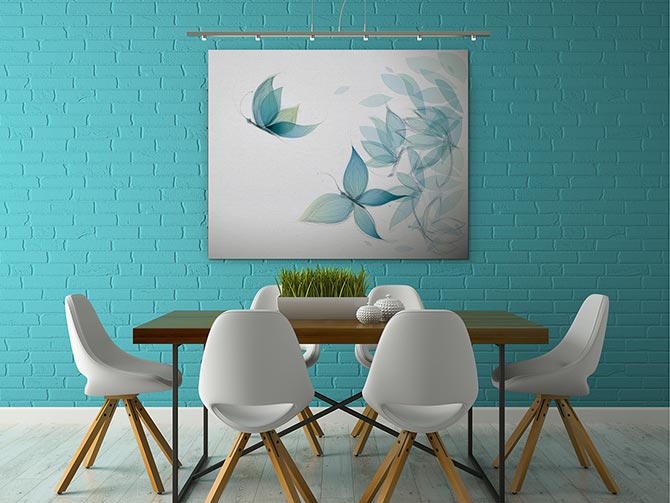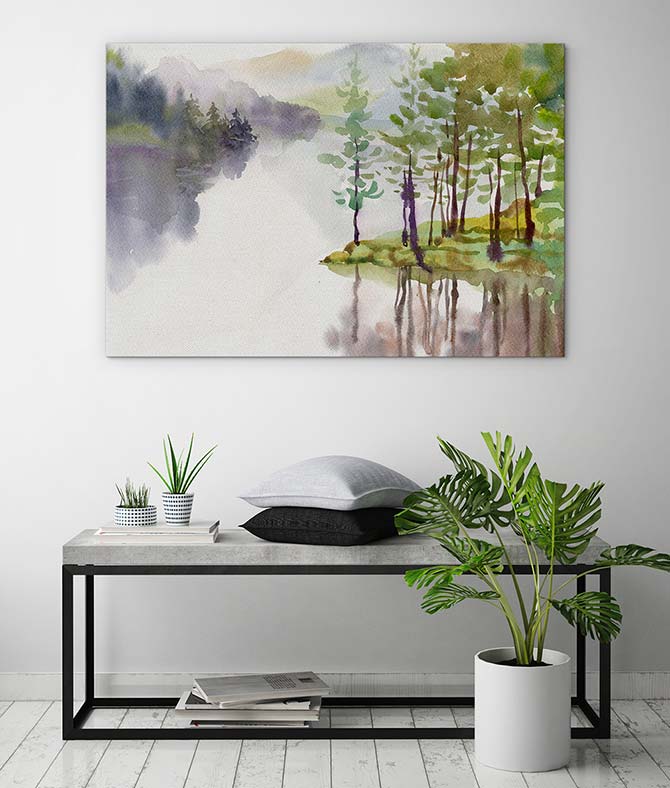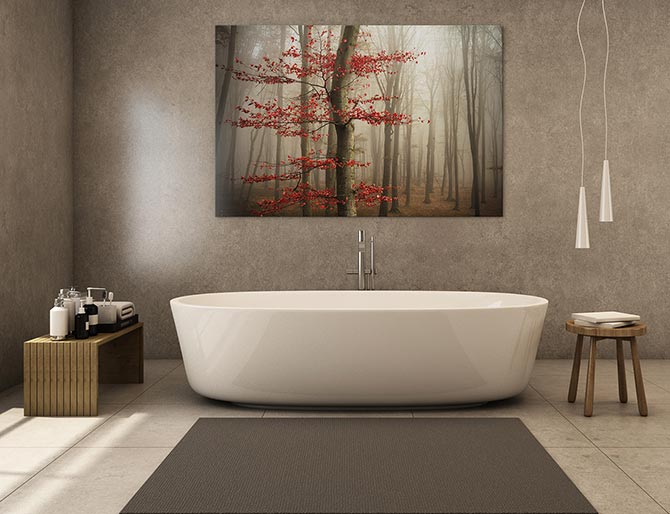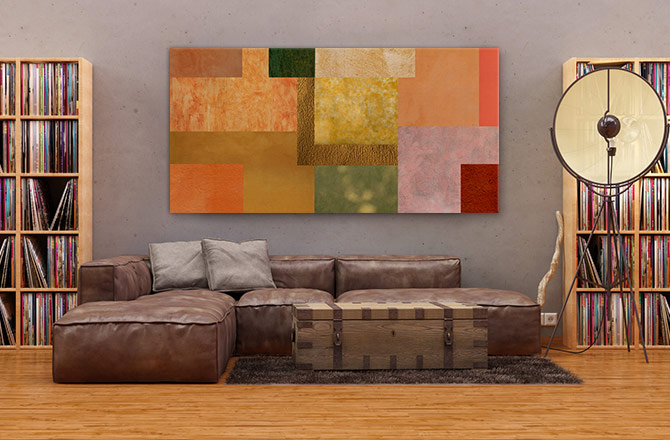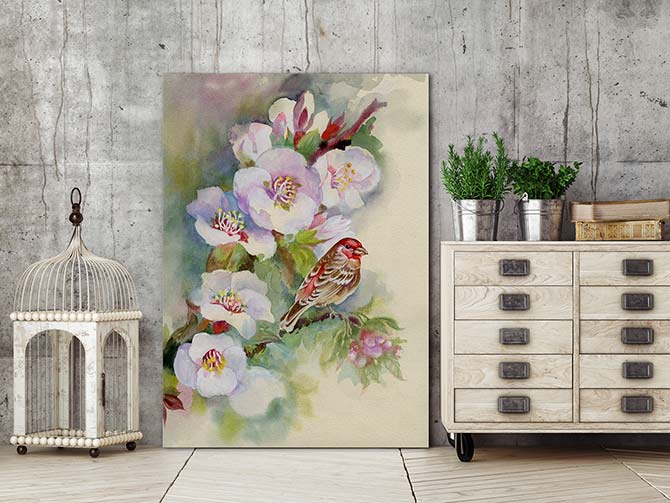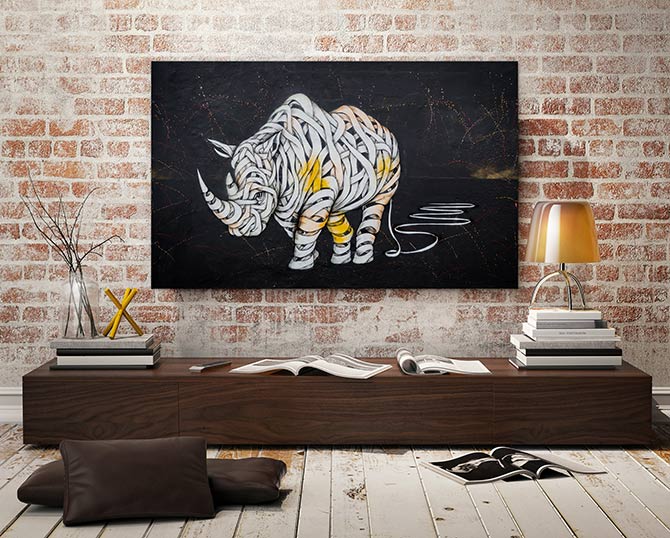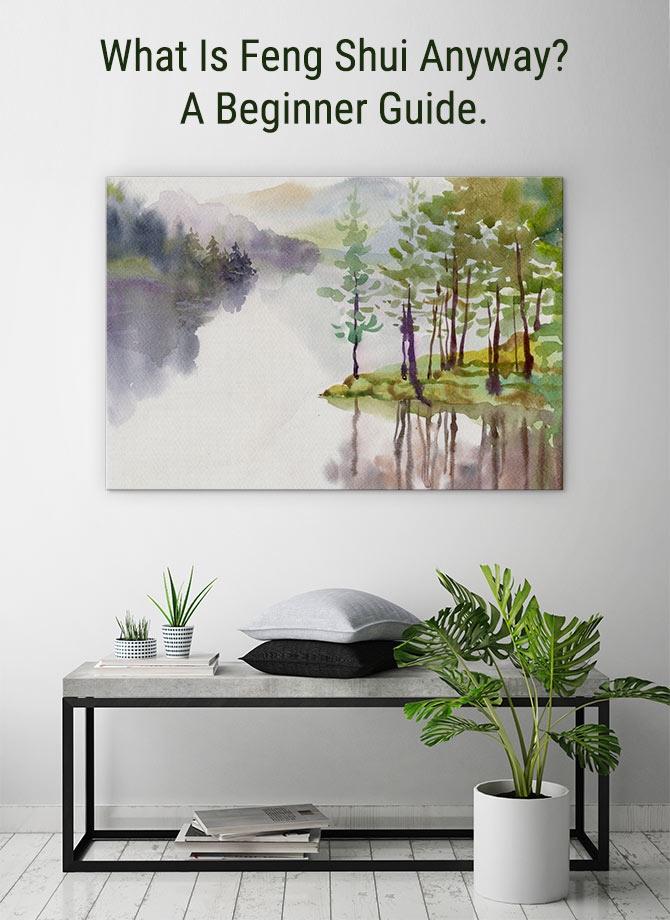
“My view on feng shui: don’t put your bed in front of the door because you won’t get in.” ― Jonas Eriksson
We often joke about Feng Shui (pronounced “fung shway”), but before writing it off as something a bit too kooky, consider that it’s been around for over 3000 years and, in interior design circles, is still going strong.
So what is Feng Shui anyway?
Developed in China, Feng Shui is part art and part science, but mostly a complex philosophy that requires a lot of study to fully understand its intricacies.
Unlike the Western world where material comfort in your living environment is valued, Feng Shui includes physical health, mental health, your relationships and personal successes in the mix.
In the home, Feng Shui helps us get our physical space in line with who we are and where we want to be. It’s about balancing our own energy with our home’s energy – and vice versa.
This involves examining how the placement of objects like furniture, ornaments, lighting and plants affects the home’s (and therefore your) energy flow.
Some popular Feng Shui theories you may have heard of include yin and yang and the five feng shui elements. These come from Taoism, a religious or philosophical tradition of Chinese origin.
1. Placing a plant in front of a big window
According to The Spruce, everything in our Universe is composed of two opposing, but deeply interconnected forces – the Yin (feminine) and the Yang (masculine).
Yin (passive energy) is for relaxation and involves calming colours, soft music, a water fountain or images of water – needed for the bedroom and spa bathroom.
Yang (active energy) is more vibrant and expressive, involving strong sounds and colours, bright lights and tall plants – needed for kitchens, home offices, front entries and dining areas.
In this interior, below, the plant in front of a big, bright window adds vibrancy to the living space (Yang) while the pastel art print provides the feminine balance (Yin).
2. Having a soft ottoman rather than a coffee table
Feng Shui philosophy includes the principle of the five elements. These are: wood, fire, earth, metal and water. Each element provides a corresponding colour: Wood: brown, green; Fire: bright yellow, red, orange, pink, purple, Earth: pale yellow, sand, beige, light brown; Metal: grey, white; Water: black, blue.
The idea is to create a room that is harmonious for the people living in it.
If you are a single bachelor or bachelorette who regularly entertains with card games and movie nights, it would make sense to decorate your living area with a coffee table in front of the television for placing drinks and snacks.
If you’re a family with young children, a soft ottoman that encourages safe movement and includes rather than excludes children from the space may be a better option.
There is certainly no one size fits all.
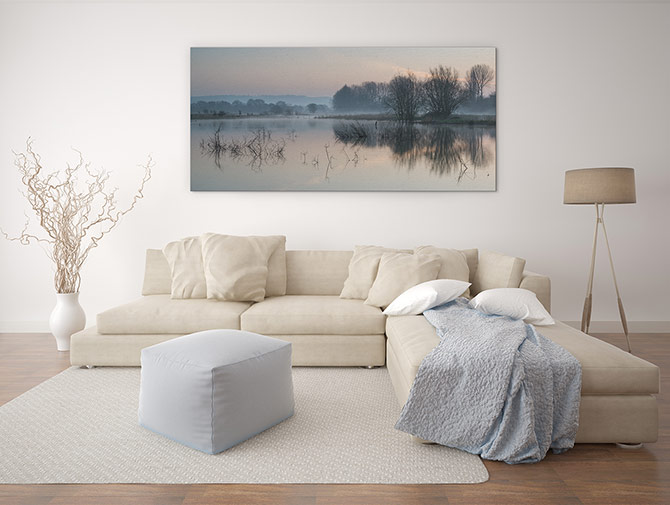
FAMILY FRIENDLY: This comfortable, child-friendly space is complemented by the gorgeous landscape, ‘Sunrise Glow Over Misty Lake’.
3. Using lighting to brighten dark areas
If you’re an entertainer and love to show everyone a good time, brighten your living and dining areas with plenty of Yang.
The colour yellow, as featured in the art print, below, is a happy, warm and stimulating colour that makes people more talkative.
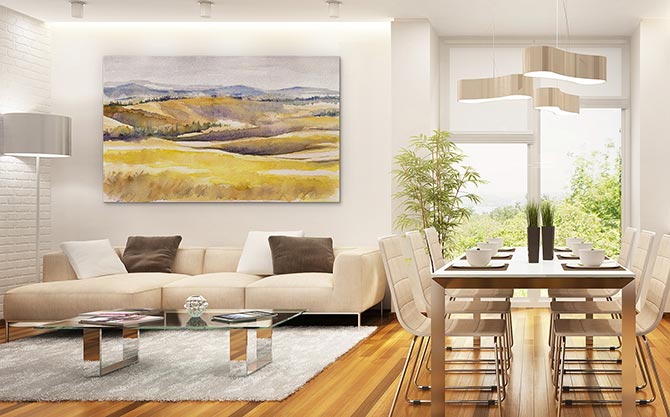
HAPPY: Stimulate good times with bright lighting combined with this warm yellow watercolour art print, ‘Tuscan Meadows’.
4. Ensuring your table is well balanced
The key to an harmonious dining area is ensuring it’s not too squishy. Be sure to give people plenty of space to get up and walk around.
It’s often useful to position chairs away from windows. Someone with their back to the window can feel vulnerable, making dining a less comforting experience than you’d expect.
If this dining area is for everyday eating rather than entertainment, using blue will provide a calming, healing, soothing spirit, ideal for the end of a hard day.
5. Using reflective metals in ornamental lighting
If a space in your home is light restricted, add some Yang or ‘active energy’ by using reflective metals in lighting like nickel, brass or bronze.
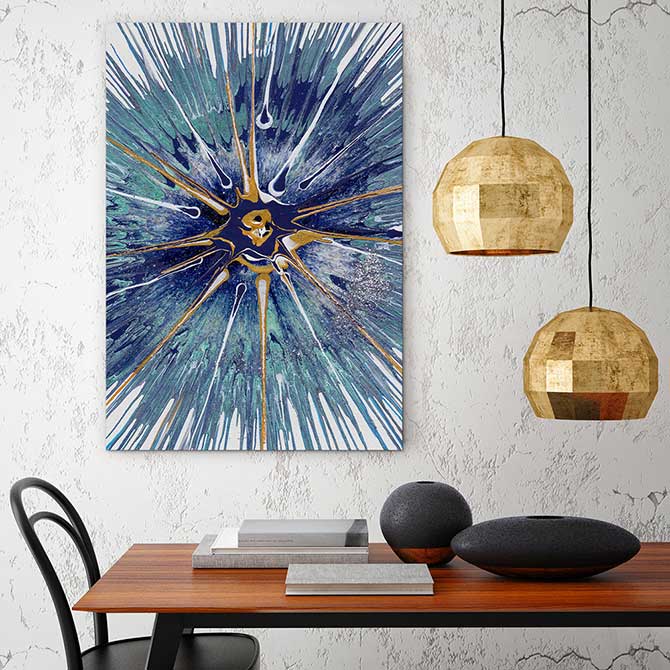
DAZZLING: Pep up the energy in your home with this exciting ‘Cassiopeia’ abstract combined with flashy metallic lighting.
6. Using ambient rather than spot lighting
As bedrooms are places for relaxation, balance a Yang interior design with some Yin lighting. Ambient rather than spot lighting is the way to go.
Good quality lighting is one of Feng Shui’s most vital Chi adjustments, so it’s important to get it right. Candles, lamps and ambient chandeliers will get the Chi energy circulating.
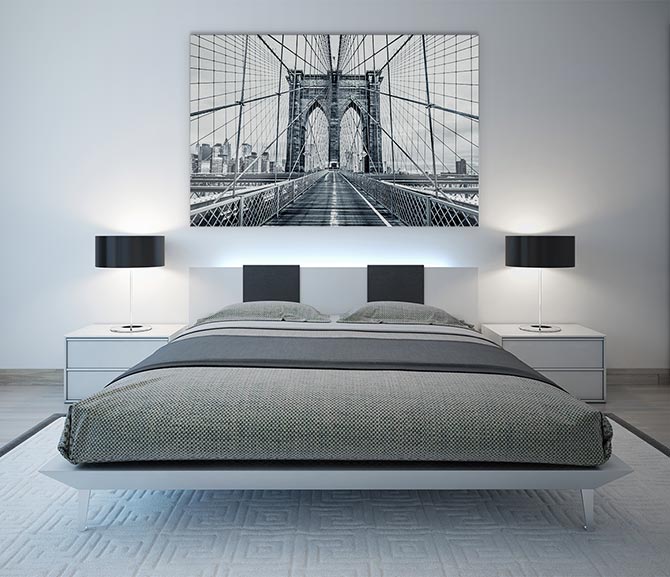
RELAX: The black (yin) and white (yang) in ‘The Brooklyn Bridge’ complements the harmonious decor, with ambient lighting providing a relaxing energy.
7. Putting plants indoors to avoid neglect
The idea of having plants indoors isn’t just about bringing the healing, restful and tranquil colour green into the home, but bringing the element of water in as well.
Fresh plants will encourage you to enter a room to water them regularly, making sure that room doesn’t become neglected.
8. Adding a big mirror that reflects the table
Often called the aspirin of Feng Shui, according to The Spruce, mirrors are ‘one of the most popular (and powerful!) Feng Shui cures’.
In fact, a big mirror in the dining room that reflects the table will bring good fortune by encouraging double the abundance. Bring it!
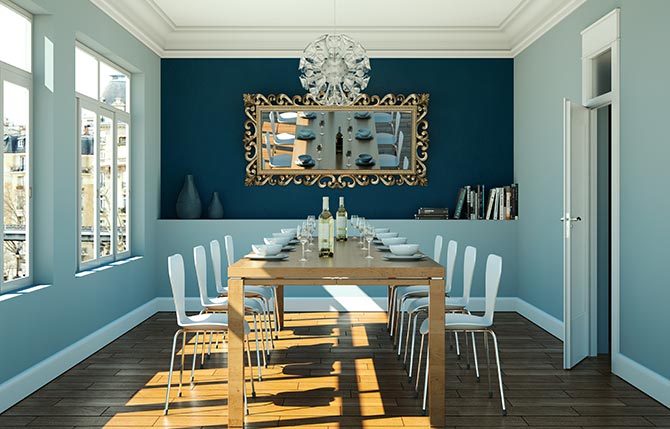
WEALTH: Bring good fortune into your life with a wall mirror that reflects the abundance of your dining table.
9. Leaving plenty of room on both sides of the bed
As tempting as it might be to place a Queen bed in a room fit for a Single, good Feng Shui requires leaving plenty of room on each side of a two-person bed, complete with two bedroom tables.
In fact, even if you’re single, the idea is to make sure the room gives you the energy to invite someone in.
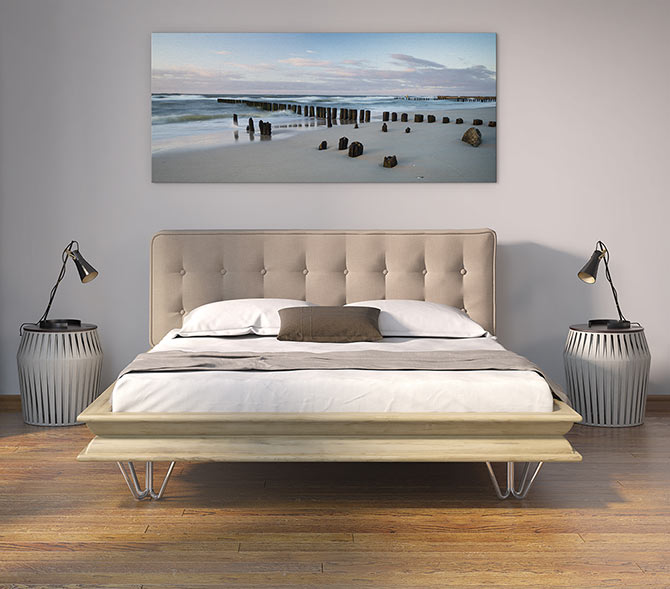
INVITING: The placement of this ‘Breakwaters On The Beach’ print above the bed is in harmony with the decor’s symmetrical style.
10. Allowing plenty of open space
We all know that clutter is not a facet of Feng Shui, but why? Clutter is a draining energy – low, stagnant and confusing. Sounds awful doesn’t it?
Interestingly, clutter wasn’t a problem in ancient times (people had fewer things), so it wasn’t really an issue that needed to be addressed using Feng Shui.
However, in modern times, a good flow of Chi is achieved by allowing plenty of open space and breathing room.
The trick is to choose furniture, ornaments and artwork that fit the space available rather than overwhelm that space.
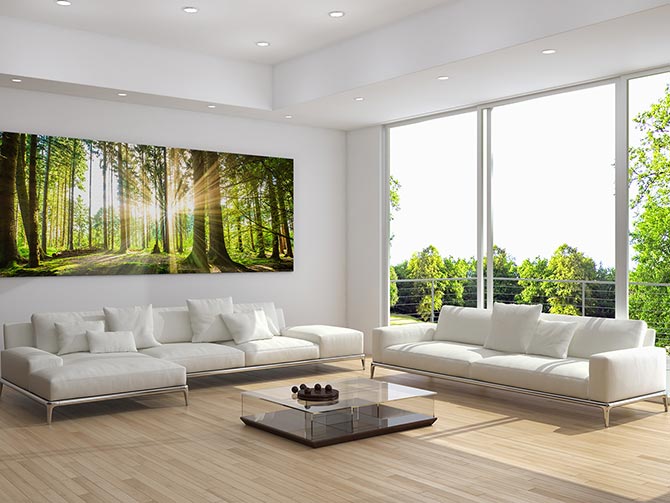
BREATHE: A glorious photographic landscape print like ‘Sunbeam Forest Panorama’ will open up a room.
11. Creating indoor fountains
Paying attention to the power element of water is a way to bring flow, freedom and creativity into your home.
If you’re the type who needs to instantly go to the toilet at the sound of running water or hates to waste electricity then an indoor water fountain may not be the right choice!
The good news is that art is an essential adjustment in the Feng Shui toolkit. According to Open Spaces Feng Shui, it’s important to make sure the art you’re living with ‘makes you feel great every time you see it.’
A work of art featuring water ticks all the boxes.
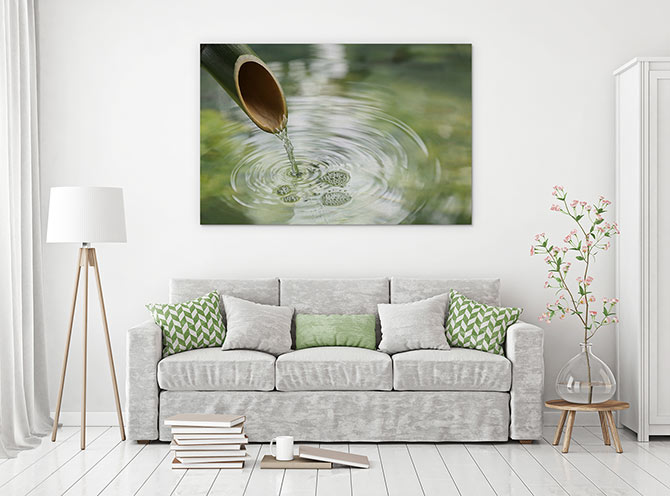
FREEDOM: Add the benefits of flowing water to a room without the mess with this striking ‘Bamboo Fountain’ print.
12. Designing a wide front entry
Want to invite wealth into your home? Of course you do! The front door is the ‘mouth of Chi energy’ and it nourishes the entire home.
As well as making sure the front door opens inwards instead of outwards, it must be the grandest door in the entire home and not be too close to the ceiling.
There must be plenty of room between the door and the ceiling for Chi energy to flow through. It also helps ensure your household’s tallest person can comfortably enter your home.
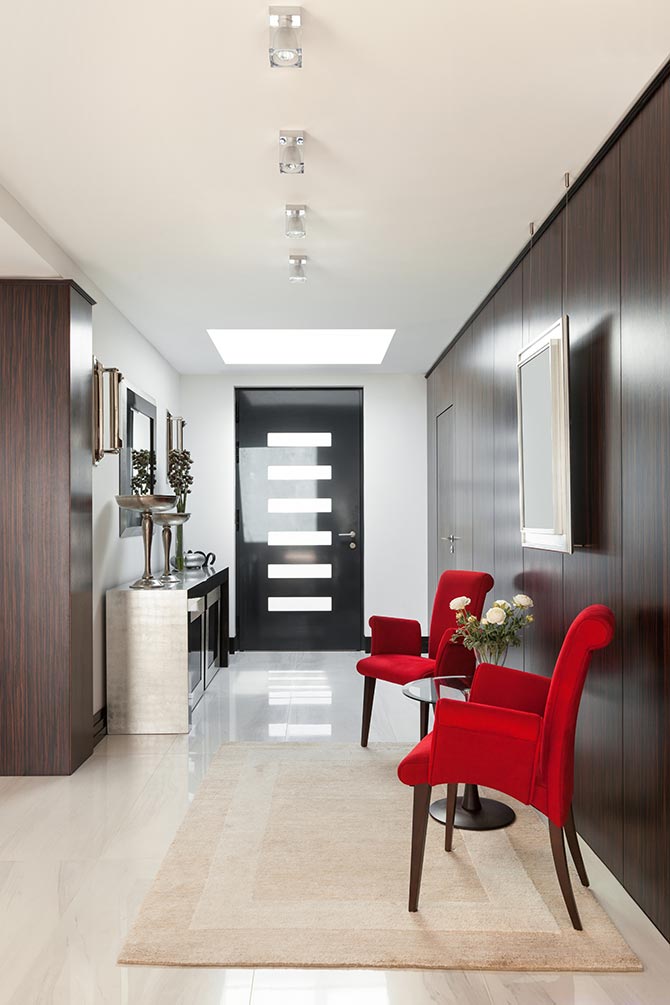
GRAND: Invite good fortune into your home with an open front entry way.
13. Making your bathroom beautiful
Don’t let your bathroom be the one room that ends up flushing away your home’s positive Chi energy.
As well as needing ample sunlight and fresh air, place a square shaped skin, chocolate brown, yellow or pink coloured rug on the ground and some soothing artwork.
Keep the door closed, the toilet lid closed and keep it clean and uncluttered at all times.
Easier said than done? Well that’s Feng Shui for you.

